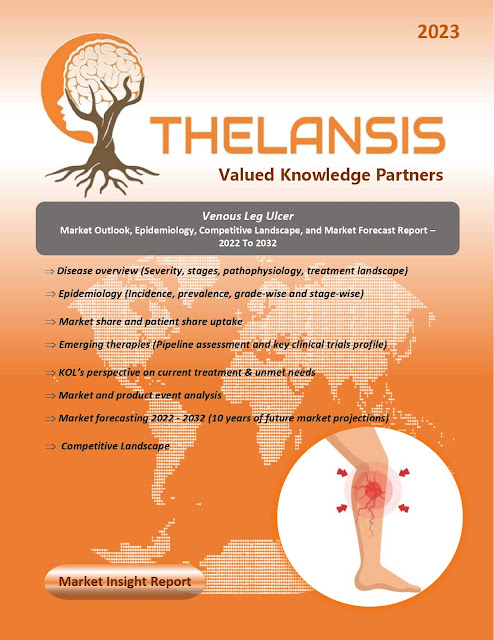Venous Leg Ulcers (VLUs) – Market Outlook, Epidemiology, Competitive Landscape, and Market Forecast Report – 2022 To 2032
Venous leg ulcers (VLUs) result from chronic venous insufficiency (CVI) and venous hypertension, typically appearing in later stages. Under normal circumstances, the contraction of calf muscles and functioning intraluminal valves encourage forward blood flow while preventing backflow. However, when retrograde flow or obstructions occur, chronic venous hypertension develops, leading to dermatologic and vascular complications that eventually lead to VLU formation. Although CVI is a well-recognized cause of VLU development, ulceration occurs infrequently (5.1%), and the reasons behind this are not entirely clear. CVI may arise from blood reflux, obstruction, or both, disrupting macro- and micro-circulatory functions. This heightened intraluminal pressure results in the leakage of proteins and the creation of fibrin cuffs, hindering the diffusion of oxygen and growth factors and triggering an inflammatory response. At the cellular level, vein wall remodeling, and varix formation involve mast cell degranulation, recruitment of leukocytes, increased presence of matrix metalloproteinase inhibitors and prostacyclin, transformation of smooth muscle cells into a non-contractile secretory phenotype, and differentiation of fibroblasts into myofibroblasts. The inflammatory environment is sustained mainly by M1 macrophages, which release IL-1α, IFN-γ, and TGF-β1. Ultimately, this sequence of chronic inflammation and compromised blood flow contributes to blood clots forming, further exacerbating fibrosis and damage to valves. This cascade of inflammatory events impairs the natural healing process, leading to the development of ulcers when injuries occur. Most risk factors for VLU development cannot be altered, and patients often have multiple factors. These include a family history of CVI, older age, female gender, previous thrombosis or pulmonary embolism, multiple pregnancies, lipodermatosclerosis, and musculoskeletal and joint disorders. Modifiable risk factors such as obesity and a sedentary lifestyle also affect venous disease. The established treatment approach for VLUs involves two main strategies: compression therapy and direct wound care. Effectively reducing leg edema is crucial for successful wound closure. Various conservative options address venous hypertension, including medical, intermittent pneumatic compression (IPC), manual lymphatic drainage, and extracorporeal shockwave therapy. For VLUs that are less than a year old and smaller than 10 cm2 upon initial assessment, the likelihood of failing to close within six months stands at 29%. This probability rises to 78% for wounds over a year old and larger than 10 cm2. Additional risk factors associated with poor healing include older age, non-white ethnicity, high body mass index, impaired calf muscle pump function, venous reflux, thrombosis, deep vein involvement, and insufficient high-level compression.
·
The estimated annual incidence of Venous leg
ulcers in the USA is 0.73 cases per 1000 person-years.
Thelansis’s “Venous Leg Ulcers (VLUs)
Market Outlook, Epidemiology, Competitive Landscape, and Market Forecast Report
– 2022 To 2032" covers disease overview, epidemiology, drug utilization,
prescription share analysis, competitive landscape, clinical practice,
regulatory landscape, patient share, market uptake, market forecast, and key
market insights under the potential Venous Leg Ulcers (VLUs) treatment
modalities options for eight major markets (USA, Germany, France, Italy, Spain,
UK, Japan, and China).
KOLs insights
of Venous Leg Ulcers (VLUs) across 8 MM market from the centre of Excellence/
Public/ Private hospitals participated in the study. Insights around current
treatment landscape, epidemiology, clinical characteristics, future treatment
paradigm, and Unmet needs.
Venous Leg Ulcers (VLUs) Market Forecast Patient
Based Forecast Model (MS. Excel Based Automated Dashboard), which Data Inputs
with sourcing, Market Event, and Product Event, Country specific Forecast
Model, Market uptake and patient share uptake, Attribute Analysis, Analog
Analysis, Disease burden, and pricing scenario, Summary, and Insights.
Thelansis Competitive Intelligence (CI) practice
has been established based on a deep understanding of the pharma/biotech
business environment to provide an optimized support system to all levels of
the decision-making process. It enables business leaders in forward-thinking
and proactive decision-making. Thelansis supports scientific and commercial
teams in seamless CI support by creating an AI/ ML-based technology-driven
platform that manages the data flow from primary and secondary sources.




Comments
Post a Comment